 |
Search the Site with

|
USS Essex (CV 9)
- later CVA 9, CVS 9 -- decommissioned -
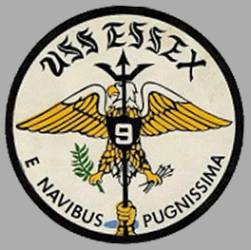 | 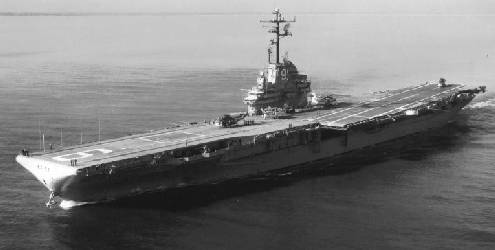 |
USS ESSEX was the lead ship of the ESSEX - class of aircraft carriers and the fourth ship in the Navy to bear the name. USS ESSEX was reclassified as CVA 9 on October 1, 1952, and on March 8, 1960, became CVS 9.
Decommissioned on June 30, 1969, the ESSEX was stricken from the Navy list on June 1, 1973, and sold by the Defense Reutilization and Marketing Service (DRMS) for scrapping on June 1, 1975.
| General Characteristics: | Awarded: 1940 |
| Keel laid: April 28, 1941 | |
| Launched: July 31, 1942 | |
| Commissioned: December 31, 1942 | |
| Decommissioned: January 9, 1947 | |
| Recommissioned: January 16, 1951 | |
| Decommissioned: June 30, 1969 | |
| Builder: Newport News Shipbuilding, Newport News, Va. | |
| Propulsion system: 8 boilers | |
| Propellers: four | |
| Aircraft elevators: three | |
| Arresting gear cables: four | |
| Catapults: two | |
| Length: 876 feet (267 meters) | |
| Flight Deck Width: 191.9 feet (58.5 meters) | |
| Beam: 101 feet (30.8 meters) | |
| Draft: 30.8 feet (9.4 meters) | |
| Displacement: approx. 40,600 tons full load | |
| Speed: 33 knots | |
| Planes: 80-100 planes | |
| Crew: approx. 3448 | |
| Armament: see down below |
Crew List:
This section contains the names of sailors who served aboard USS ESSEX. It is no official listing but contains the names of sailors who submitted their information.
- Click here to view the list.
- Click here
to see which USS ESSEX memorabilia are currently for sale on ebay.
USS ESSEX Cruise Books:
- World War II Cruise Book 1942-46
- Air Task Group Two WestPac Cruise Book 1952-53
- WestPac Cruise Book 1953-54
- WestPac Cruise Book 1954-55
- WestPac Cruise Book 1956-57
- Around the Horn Cruise Book 1957
- Mediterranean and Indian Ocean Cruise Book 1958
- Mediterranean Cruise Book 1959-60
- Mediterranean Cruise Book 1960
- NorLant Cruise Book 1961-62
- Mediterranean and Indian Ocean Cruise Book 1963
- NorLant Cruise Book 1964
- Mediterranean Cruise Book 1967
About the different armament:
- 1943: 12 5-inch (12.7 cm) 38 caliber guns, 32 40mm guns and 44 20mm guns
- 1951: 8 5-inch (12.7 cm) 38 caliber guns and 28 3-inch (7.6 cm) 50 caliber guns
- 1957: 7 5-inch (12.7 cm) 38 caliber guns and 14 3-inch (7.6 cm) 50 caliber guns
- 1959: 7 5-inch (12.7 cm) 38 caliber guns
- 1964: 4 5-inch (12.7 cm) 38 caliber guns
Accidents aboard USS ESSEX:
| Date | Where | Events | |||||
|---|---|---|---|---|---|---|---|
| November 25, 1944 | off the Philippines | A kamikaze hits the port edge of USS ESSEX' flight deck landing among planes gassed for takeoff, causing extensive damage, killing 15, and wounding 44. Following quick repairs the ESSEX is able to resume operations in mid-December. 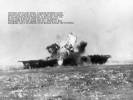 | |||||
| September 16, 1951 | off Korea | A F2H Banshee fighter which was damaged on a combat mission, crashes into aircraft parked on the forward flight deck while attempting to land on the ESSEX causing an explosion and fire which kills seven.
| |||||
| January 18, 1958 | USS ESSEX is damaged by fire at sea. | ||||||
| May 28, 1959 | east of Jacksonville, Fla. | A FJ Fury jet crashes aboard USS ESSEX causing explosions and fire, killing two, and injuring 21. | |||||
| December 16, 1963 | west of the Azores | USS ESSEX, en route to the United States, is struck by two heavy waves causing a radar mast to snap. The mast falls to the deck, damaging both the radar and aircraft. | |||||
| November 11, 1966 | 350 miles east of Morehead City, NC | USS NAUTILUS (SSN 571) collides with the USS ESSEX while running submerged during underway replenishment exercises. Both ships return to port unassisted. The submarine receives extensive damage to its sail area and goes to New London, CT. The ESSEX sustains an open hull cut in the bow area and proceeds to Norfolk, Va. | |||||
| January 27, 1967 | 5 miles off Puerto Rico | USS ESSEX runs aground during training operations off Puerto Rico. |
History of USS ESSEX:
USS ESSEX was launched 31 July 1942 by Newport News Shipbuilding and Dry Dock Co. sponsored by Mrs. Artemus L. Gates, wife of the Assistant Secretary of the Navy for Air; and commissioned 31 December 1942, Captain D. B. Duncan command ing. She was reclassified (CVA 9) on 1 October 1952, and (CVS 9) on 8 March 1960.
Following her shakedown cruise ESSEX sailed to the Pacific in May 1943 to begin a succession of victories which would bring her to Tokyo Bay. Departing Pearl Harbor, she participated with Task Force 16 (TF 16) in carrier operations against Marcus Island (31 August 1943); was designated flagship of TF 14 and struck Wake Island (5-6 October); launched an attack with Task Group 50.3 (TG 50.3) against the Gilbert Islands where she also took part in her first amphibious assault, the landing on Tarawa (18-23 November). Refueling at sea, she cruised as flagship of TG 50.3 to attack Kwajalein (4 December). Her second amphibious assault delivered in company with TG 58.2 was against the Marshalls (29 January-2 February 1944).
ESSEX in TG 68.2 now joined with TG 58.1 and 58.3, to constitute the most formidable carrier striking force to date, in launching an attack against Truk (17-18 February 1944) during which eight Japanese ships were sunk. En route to the Marianas to sever Japanese supply lines, the carrier force was detected and received a prolonged aerial attack which it repelled in a businesslike manner and then continued with the scheduled attack upon Saipan, Tinian and Guam (23 February).
After this operation ESSEX proceeded to San Francisco for her single wartime overhaul. She then joined carriers USS WASP (CV 18) and USS SAN JACINTO (CVL 30) in TG 12.1 to strike Marcus Island (19-20 May 1944) and Wake (23 May). She deployed with TF 58 to support the occupation of the Marianas (12 June-10 August); sortied with TG 38.3 to lead an attack against the Palau Islands (6-8 September), and Mindanao (9-10 September) with enemy shipping as the main target, and remained in the area to support landings on Peleliu. On 2 October 1944, she weathered a typhoon and 4 days later departed with TF 38 for the Ryukyus.
For the remainder of 1944 she continued her frontline action, participating in strikes against Okinawa (10 October), and Formosa (12-14 October), covering the Leyte landings, taking part in the battle for Leyte Gulf (24-25 October), and continuing the search for enemy fleet units until 30 October when she returned to Ulithi, Caroline Islands, for replenishment. She resumed the offensive and delivered attacks on Manila and the northern Philippine Islands during November. On 25 November, for the first time in her far-ranging operations and destruction to the enemy, ESSEX received injury. A kamikaze hit the port edge of her flight deck landing among planes gassed for takeoff, causing extensive damage, killing 15, and wounding 44.
This "cramped her style" very little. Following quick repairs we find her with 3rd Fleet off Luzon supporting the occupation of Mindoro (14-16 December). She rode out the typhoon of 18 December 1944 and made special search for survivors afterwards. With TG 38.3 she participated in the Lingayen Gulf operations, launched strikes against Formosa, Sakishima, Okinawa, and Luzon. Entering the South China Sea in search of enemy surface forces, the task force pounded shipping and conducted strikes on Formosa, the China coast, Hainan, and Hong Kong. ESSEX withstood the onslaught of the third typhoon in four months (20-21 January 1945) before striking again at Formosa, Miyako Shima and Okinawa (26-27 January).
During the remainder of the war she operated with TF 58, conducting attacks against the Tokyo area (16-17, and 25 February) both to neutralize the enemy's airpower before the landings on Iwo Jima and to cripple the aircraft manufacturing industry. She sent support missions against Iwo Jima and neighboring islands, but from 23 March to 28 May 1945 was employed primarily to support the conquest of Okinawa.
In the closing days of the war, ESSEX took part in the final telling raids against the Japanese home islands (10 July-15 August 1945). Following the surrender, she continued defensive combat air patrols until 3 September when she was ordered to Bremerton, Wash., for inactivation. On 9 January 1947, she was placed out of commission in reserve.
Modernization endowed ESSEX with a new flight deck, and a streamlined island superstructure, on 16 January 1951 when recommissioned, Captain A. W. Wheelock commanding.
After a brief cruise in Hawaiian waters she began the first of three tours in Far Eastern waters during the Korean war. She served as flagship for Carrier Division 1 and TF 77. She was the first carrier to launch F2H Banshee twinjet fighters on combat missions; on 16 September 1951 one of these planes, damaged in combat, crashed into aircraft parked on the forward flight deck causing an explosion and fire which killed seven. After repairs at Yokosuka she returned to frontline action on 3 October to launch strikes up to the Yalu River and provide close air support for U.N. troops.
On 1 December 1953 she started her final tour of the war, sailing the China Sea with the Peace Patrol. From November 1954 to June 1955 she engaged in training exercises, operated for three months with the 7th Fleet, assisted in the Tachen Islands evacuation, and engaged in air operations and fleet manuevers off Okinawa.
In July 1955 ESSEX entered Puget Sound Naval Shipyard for repairs and extensive alterations, including installation of an angled flight deck. Modernization completed, she rejoined the Pacific Fleet in March 1956. For the next 14 months the carrier operated off the west coast, except for a six-months cruise with the 7th Fleet in the Far East. Ordered to join the Atlantic Fleet for the first time in her long career, she sailed from San Diego on 21 June 1957, rounded Cape Horn, and arrived in Mayport, Fla., on 1 August.
In the fall of 1957, ESSEX participated as an anti-submarine carrier in the NATO exercises, Strike Back, and in February 1958 deployed with the 6th Fleet until May when she shifted to the eastern Mediterranean. Alerted to the Middle East crisis on 14 July 1958 she sped to support the U.S. Peace Force landing in Beirut, Lebanon, launching reconnaissance and patrol missions until 20 August. Once again she was ordered to proceed to Asian waters, and transitted the Suez Canal to arrive in the Taiwan operational area where she joined TF 77 in conducting flight operations before rounding the Horn and proceeding back to Mayport.
ESSEX joined with the 2nd Fleet and British ships in Atlantic exercises and with NATO forces in the eastern Mediterranean during the fall of 1959. In December she aided victims of a disastrous flood at Frejus, France.
In the spring of 1960 she was converted into an ASW Support Carrier and was thereafter homeported at Quonset Point, R.I. She operated as flagship of Carrier Division 18 and Anti-submarine Carrier Group Three. She conducted rescue and salvage operations off the New Jersey coast for a downed blimp; cruised with midshipmen, and was deployed on NATO and CENTO exercises. In November 1960, she joined the French navy in Operation Jet Stream.
ESSEX was decommissioned 30 June 1969. She was stricken from the Navy List on 1 June 1973, and sold by the Defense Reutilization and Marketing Service (DRMS) for scrapping 1 June 1975.
ESSEX received the Presidential Unit Citation, and 13 battle stars for World War II service; four battle stars and the Navy Unit Commendation for Korean war service.
USS ESSEX Image Gallery:
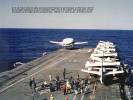 |  | 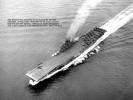 | 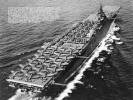 |  |
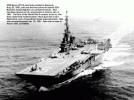 | 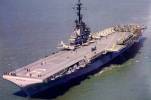 | 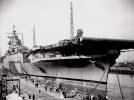 | 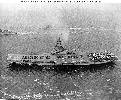 | 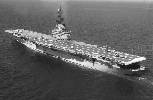 |
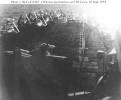
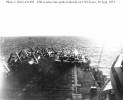
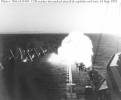
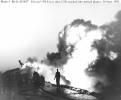
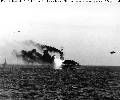
 Back to Carriers list.
Back to Carriers list.